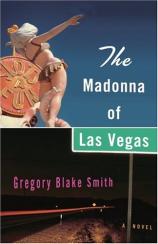Reading Group Guide
Discussion Questions
The Madonna of Las Vegas

1. Packed with subterfuge, comic sleight-of-hand, and metaphysical subtexts: what challenges does this novel pose for discussion? What stable point of reference-Cosmo's love for Cathy? his horror at the degenerate culture of the Strip?-can you find to help anchor your response to the novel? Consider the first chapter: how does its polarities-Cosmo standing in line to commit suicide while remembering how he and Cathy met and married in Venice-lay the groundwork for the conflict in the book?
2. Cosmo is obsessed with the false, using words like "inauthenticity," "parody," "caricature," "plagiarism," "mockery," and "desecration" to describe not only Las Vegas, but his life and the world at large. What trappings of the false does Cosmo purposely surround himself with? To what extent does Cosmo find comfort in the absurdity of his life? Does his relationship with Ann allow him to transcend this pattern by the end of the novel, or does their union represent a total surrender to "plagiarism?"
3. As Cosmo works on the faux Sistine ceiling, he considers Dante Alighieri's concept of contrapasso, "the idea that the nature of one's punishment in the afterlife would be derived from the nature of one's sins in the earthly life" (p. 40). What specific "sin" from Cosmo's marriage haunts him? What does he perceive as his corresponding punishment? What about the narrator's suggestion: "Or was he just hopelessly in need of moral symmetry? Cosmo Dust jury-rigging a sin to match the suffering. All by way of preserving the security of moral cause and effect because guilt was an easier row to hoe than the blank of undeserved suffering" (p. 41)?
4. As one critic sees it, Smith's work is a "blend of comic buffoonery and subtle seriousness." And indeed, at the heart of this layered, operatic, multidimensional story is the tale of one man's quest for salvation among the everyday. How do you reconcile the more extravagant elements of the novel with its central longing for the ordinary: man, woman, and child?
5. One thing a reader of The Madonna of Las Vegas must come to terms with is the novel's use of Roman Catholic iconography. Is it blasphemous? Reverential? Or just another element of Western Civilization to be used for decorative purposes along the Strip? How does the religious imagery help carry the novel's meaning?
6. A recurring motif in the book is CNN and its continuing coverage of "the Apocalypse." How does the idea of apocalypse-the destruction of the world and the salvation of the few-work metaphorically in the novel?
7. At one point, Cosmo thinks the mafia should be put in the Smithsonian. And indeed the novel is filled with references to icons of American culture. What other ones can you identify? Do they exist in a pure state, or are they qualified, or even debased in some way?
8. Kenotic theology is a controversial branch of Christology that emerged in the 19th century, rooted in St. Paul's letter to the Philippians. The gist of kenosis is the idea that Christ deliberately emptied himself of his divinity and all its privileges in order to live a fully human life. What role does the Kenotic Messiah play in the novel? How is the idea of kenosis-the emptiness out of which something comes-important to the novel?
9. How far does the author take the pervasive concept of "symbol and referent. The thing itself and its parody" (p. 20)? What characters, scenes, settings, actions can be seen as derivative of some more authentic original? What might the author be saying about the contemporary world?
10. Cosmo repeatedly refers to the baby as a "messiah", and describes him as performing miracles and "sent to save." When and why does he begin to refer to Ann as a messiah as well? In what way can the novel be read as a parody of a Nativity narrative?
11. As Cosmo waits for Ann and the baby in the piazza of the Venetian, he is mesmerized by the statue of the Madonna. "She, too, was caught in all this. A bizarre fate!…he couldn't rid himself of the power in the image. Her, caught in all this…the inclined head, the soft face, the folds of her clothing, the compassion. Caught in all this" (p. 246). What does the author intend with the repeated phrase, "caught in all this"? What epiphany about love does Cosmo attribute to this encounter with the statue? Why does it immediately precede Cosmo's ominous visit by the maitre d' (Cathy's apparent killer)?
12. Cosmo and Ann's refusal to be swayed by the maitre d' and his insistence on their cosmic codependence with him-"We penetrate. We depend" (p. 256)-represents the first time they have said no to fate. What gives them the strength to do so? What chain reaction does this act of self-determination set up?
13. A conventional murder mystery ends with the reader's learning who the murderer is, but in this book we never really learn who killed Candi. Indeed, suspects seem to multiply as the story progresses. Why? How does the book both fulfill and subvert the conventions of the murder mystery?
14. Venice occupies an important place in the novel. It is where Cathy and Cosmo first fall in love; its Las Vegas incarnation embodies the decadence of the Strip; and it is where Ann and Cosmo flee to make a new life. Discuss Venice as a symbol that carries some of the novel's thematic freight. How do you read the ending? Is it a conventionally happy ending? In what way does the millennium celebration with its masks and masquerade color the final scene?
The Madonna of Las Vegas
- Publication Date: August 23, 2005
- Paperback: 288 pages
- Publisher: Three Rivers Press
- ISBN-10: 1400081866
- ISBN-13: 9781400081868








